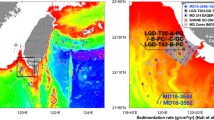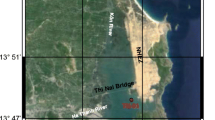Abstract
In order to compare two widely used piston-coring techniques, parallel cores were taken with both a Kullenberg and a Livingstone corer in the deepest part of Soppensee (25 m), a small eutrophic Swiss lake containing varved sediments. The cores were taken within a horizontal distance of 3 m and yield comparable stratigraphic records. Differences in millimetre-scale microstructure are attributed to primary sedimentation processes at the water/sediment interface. Sediment thin-sections, as well as sediment x-radiograph investigations, reveal no difference in microstructure that could unequivocally be attributed to one of the coring methods used. The differences in deposition are therefore thought to reflect the inherent variability of lacustrine sedimentation in Soppensee.
Major differences in overall core recovery do occur, however, in organic-rich, highly porous sediments. These variations are primarily attributed to differential gas expansion. Actual sediment-accumulation rates can therefore only be correctly estimated if the sedimentary record can be constrained within a high-resolution temporal framework, e.g. by annual laminations.
Similar content being viewed by others
References
Blomqvist, S., 1985. Reliability of core sampling of soft bottom sediment-an in situ study. Sedimentology 32: 605-612.
Blomqvist, S., 1991. Quantitative sampling of soft-bottom sediments: problems and solutions. Marine Ecology Progress series 72: 295-304.
Crusius, J. & F. Anderson, 1991. Core compression and surficial sediment loss of lake sediments of high porosity caused by gravity coring. Limnology and Oceanography 36: 1021-1031.
Cumming, B. F., J. R. Glew, J. P. Smol, R. B. Davis & S. A. Norton, 1993. Comment on `Core compression and surficial sediment loss of lake sediments of high porosity caused by gravity coring' (Crusius & Anderson). Limnology and Oceanography 38: 695-699.
Hongve, D. & A. H. Erlandsen, 1979. Shortening of surface sediment cores during sampling. Hydrobiologia 65: 283-287.
Kelts, K., U. Briegel, K. Ghilardi & K. Hsu, 1986. The limnogeology-ETH coring system. Schweizerische Zeitschrift für Hydrologie 48: 104-117.
Kullenberg, B., 1947. The piston core sampler. Svenska Hydro-Biol. Komm. Skr. 3: 1-46.
Lebel, J., N. Silverberg & B. Sundby, 1982. Gravity core shortening and pore water chemical gradients. Deep Sea Research 29A: 1365-1372.
Livingstone, D. A., 1955: A lightweight piston sampler for lake deposits. Ecology 36: 137-139.
Mackereth, F. J. H., 1958. A portable piston sampler for lake deposits. Limnol. Oceanogr. 3: 181-191.
Mehl, J. & J. Merkt, 1992. X-ray radiography applied to laminated lake sediments. Geological Survey of Finland Special Paper 14: 77-85.
Merkt, J., 1971. Zuverlässige Auszählung von Jahresschichten in Seesedimenten mit Hilfe von Gross-Dünnschliffen. Archiv für Hydrobiologie 69: 145-154.
Merkt, J. & H. J. Streif, 1970. Stechrohr-Bohrgeräte für limnische und marine Lockersedimente. Geotogisches Jahrbuch 88: 137-148.
Ohle, W., 1978. Ebulition of gases from sediment, conditions, and relationship to primary production of lakes. Verb. int. Ver. Limnol. 20: 957-962.
Piggot, C. S., 1941. Factors involved in submarine core sampling. Bulletin of the Geological Society of America 52: 1513-1524.
Ross, D. A. & W. R. Riedel, 1967. Comparison of upper part of some piston cores with simultaneously collected open-barrel cores. Deep Sea Research 14: 285-294.
Schneider, R., 1974: Vergleich der Bohrmethoden Hiller und Livingstone. Pollen et Spores 16: 489-492.
Stowe D. A. V. & A. E. Aksu, 1978. Disturbances in soft sediments due to piston coring. Mar. Geol. 28: 135-144.
Sturm, M., 1990. Die Sedimente der verschiedenen Becken des Luganersees. Archive der Scc-Entwicklung. Int. Symposium Limnol. Aspects and Management of Lake of Lugano: 11.
Wieckowski, K., 1989. A new method of coring in deep lakes with rod-operated samplers. Boreas 18: 357-358.
Wright, H. E. Jr. 1980. Cores of soft lake sediments. Boreas 9: 107-114.
Wright, H. E. Jr., 1993. Core compression. Limnology and Oceanography 38: 699-701.
Author information
Authors and Affiliations
Rights and permissions
About this article
Cite this article
Lotter, A.F., Merkt, J. & Sturm, M. Differential sedimentation versus coring artifacts: a comparison of two widely used piston-coring methods. Journal of Paleolimnology 18, 75–85 (1997). https://doi.org/10.1023/A:1007929422169
Issue Date:
DOI: https://doi.org/10.1023/A:1007929422169




